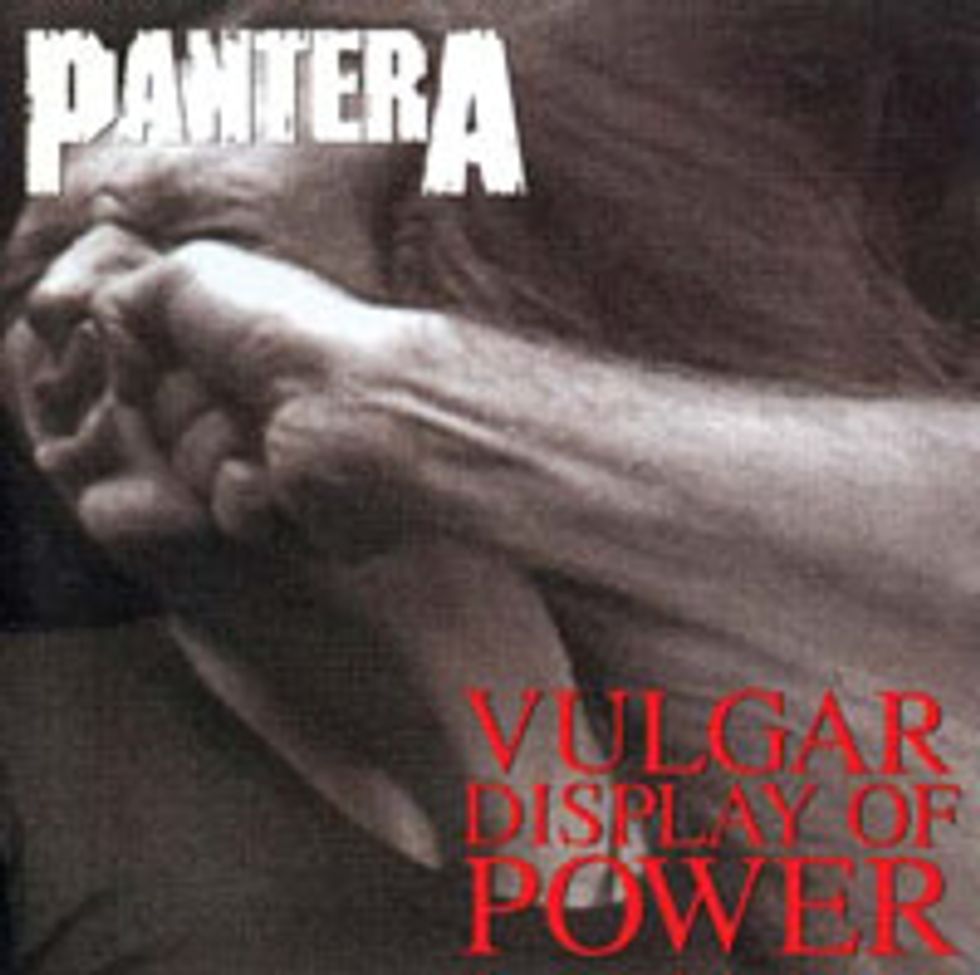| The sound engineers at OEM Inc. have spent thousands of hours with the original masters of the most famous songs ever recorded. They use them to create products like Jammit, an iPhone app that allows you to remix and play along with those original tracks. There are many, many things to learn from those original tracks. Through a partnership with Gearhead Communications, OEM Inc. engineers are sharing their discoveries exclusively with Premier Guitar readers in what we like to call Secrets of the Masters |
 Pantera had been refining their heavy metal chops since the early ’80s and although the success of “Cowboys From Hell” put them on the map, it was their next album, ’92’s Vulgar Display of Power, that established them as the band that would conquer the world of hard-hitting, powerful rock music. Even as grunge was putting an end to anything even closely related to “metal,” the signature song from Pantera’s second major release (and sixth studio album), “Walk,” could knock the teeth out of anyone who dared to listen to it loud enough. It was this song that first introduced me, and probably a lot of other people, to Pantera’s unique brand of heavy metal.
Pantera had been refining their heavy metal chops since the early ’80s and although the success of “Cowboys From Hell” put them on the map, it was their next album, ’92’s Vulgar Display of Power, that established them as the band that would conquer the world of hard-hitting, powerful rock music. Even as grunge was putting an end to anything even closely related to “metal,” the signature song from Pantera’s second major release (and sixth studio album), “Walk,” could knock the teeth out of anyone who dared to listen to it loud enough. It was this song that first introduced me, and probably a lot of other people, to Pantera’s unique brand of heavy metal. The first time I heard the song, the plodding rhythm and menacing vocals grabbed my attention while the overall sonic quality of the song grabbed me by the neck and smashed me into a wall of sound. The guitar was the most defined, razor sharp (without being harsh) thing I’d ever heard, and the production sounded so simple yet so full and huge. Since then, I’ve always wondered what the secret ingredient was to pulling off such a powerful sound. After deciding to include Pantera in our initial release of Jammit apps, I was excited to find out.
First Steps
 Upon receiving the 2" 24-track tapes, the first thing I noticed was the title, “The Walk.” As the tape was being transferred to digital audio, I was crossing my fingers that this was the song I knew simply as “Walk,” and not an un-used version or demo. It didn’t take long for me to recognize that familiar intro riff and 12/8 time signature, and once the first line of lyrics came out of the speakers, I knew this was the master take that was used on the record. The one thing I didn’t expect was that there was also a slave tape. Having heard the song hundreds of times, I didn’t anticipate that the song would have more than 24 tracks. I began soloing some of the tracks from the slave and quickly realized that it was mostly experimental stuff that didn’t get used in the mix. There were a few alternate background vocal parts, loops made from guitar recordings that ran throughout the song, an alternate bass sound, etc. I have a strong feeling that at some point the band or producer Terry Date questioned the simplicity of the song and tried to incorporate some flashier production. In the end, however, almost every track that was used in the final mix lived on the master tape.
Upon receiving the 2" 24-track tapes, the first thing I noticed was the title, “The Walk.” As the tape was being transferred to digital audio, I was crossing my fingers that this was the song I knew simply as “Walk,” and not an un-used version or demo. It didn’t take long for me to recognize that familiar intro riff and 12/8 time signature, and once the first line of lyrics came out of the speakers, I knew this was the master take that was used on the record. The one thing I didn’t expect was that there was also a slave tape. Having heard the song hundreds of times, I didn’t anticipate that the song would have more than 24 tracks. I began soloing some of the tracks from the slave and quickly realized that it was mostly experimental stuff that didn’t get used in the mix. There were a few alternate background vocal parts, loops made from guitar recordings that ran throughout the song, an alternate bass sound, etc. I have a strong feeling that at some point the band or producer Terry Date questioned the simplicity of the song and tried to incorporate some flashier production. In the end, however, almost every track that was used in the final mix lived on the master tape. I began to set up the mix by going through each track one by one, taking note of the instrumentation. The tracks that ended up in the final mix included the following: kick, snare, hi-hat, toms left, toms right, overhead left, overhead right, bass direct, bass amp, two rhythm guitar tracks, two guitar tracks that had various accent guitar parts, a guitar solo track that was a comp of several other guitar solo takes, two lead vocal tracks, a low octave vocal track, and six additional tracks of the famous “re… spect… walk” barks.
Getcha’ Gear
I immediately jumped on the guitars. I wanted to hear what mix trickery would be needed to get the sound that Dimebag is so closely associated with. My initial observation, slightly anti-climatic yet exciting nonetheless, was that the sound you hear on the record is the sound coming from Dimebag’s fingers playing his Bill Lawrence (pickups)-equipped Dean From Hell guitar plugged into a solid-state Randall amplifier. Other than some hi EQ boost and a slight dip in the mids, the sound on tape is the sound you hear on the record—no trickery needed. What struck me the most about the guitar tracks was how locked his parts were. Through the entire song the rhythm sound was a lead and double and they were about as tight as I’ve ever heard on any recording. There were only certain sections where you could actually tell there were two guitars playing. Amazing!
The other observation worth noting is Dimebag’s judicious use of a noise gate. Between every rhythmic stop and pause there was absolutely no amp hiss, hum or fret noise. This method of trimming the noise leftover when resting on a note created a cool effect that helped maintain the tightness of the guitar tracks.
Flying Solo
As I made my way to the guitar solo, I started to feel a similarity between Pantera and Van Halen. I know it sounds crazy because the music is so different, but there are definite similarities between Dimebag’s approach to this song and Eddie’s approach to the first Van Halen album— consider the minimal use of guitar overdubs and the how the rhythm guitars drops out when it’s solo time. Most bands around this time would layer guitars upon guitars upon guitars, but during the solo to “Walk” there was only one guitar track playing (using the neck pickup).
 Dimebag in 1992. Photo by Stuart Taylor courtesy of Frank White Photo Agency. |
The last thing I noticed about the guitar parts, which was kind of a surprise to me, was that there were overdubs during the outro of the song: an additional rhythm track and a lead solo track. Although you can hear them in the mix, they definitely weren’t featured. Being able to isolate that lead part fully revealed that Dimebag was doing a really cool counter melody with some insanely well-controlled whammy bar work, something that Dimebag is still revered for to this day. Looking back, it would have been great to hear more of this in the final mix.
Bass from Hell
Moving on to the bass—I was really impressed with the sound of Rex Brown’s amp. Most mixes rely on the direct sound and then mix in the amp for flavor, but I found that using more of the amp gave me a sound that was closer to the original mix. The style in which Rex plays really has a lot to do with the power of the sound. It drives in a way that is almost a hybrid between a guitar and percussion instrument. By playing chords in the chorus instead of just single notes, he really fills out the sound like a bassist is supposed to. The whole band is such a tight machine but soloing the bass with the guitars exemplifies how locked they really are.
Drums from Hell
When I dug into the drums I was pleasantly surprised that the kick and snare drum on tape were actually used in the mix. I always assumed the tight, clicky kick drum was a triggered sample. I used a sample in my Jammit mix to accent certain frequencies of the spectrum but the original kick itself had the character heard on the albums. The snare sounded a little more augmented and was actually the hardest part of the mix for me to match. It had a very distinct crack and reverb that gave it a strong imprint within the mix. I had to scroll through a bunch of ’verbs before finding a starting point that gave the drums that familiar size. The drums on tape are very dry and no room mics were recorded; it takes reverb to give the illusion of Vinnie Paul playing in a large arena. Like Dimebag’s guitar and Rex’s bass, the drums have their own part of the mix carved out; when played with the rest of the instruments, they are part of a tight and powerful combination.
Vocals from Hell
Phil Anselmo’s vocals in this song really put the cap on this aggressive metal staple. The simplicity of the track layout follows suit with the rest of the mix. There were two lead vocal tracks, which played off each other and slightly overlapped in the verse, a low octave vocal doubling the pre-chorus and then a stack of background parts of Phil layering the chorus hook “Re… spect… walk…” I’ve heard several stories of Terry Date recording singers in the control room with a Shure SM58 and no headphones, but for this song it’s hard to imagine that was the case. There was very little, if any, leakage in the vocal microphone and the sound is so consistent and even that it would have been tough to get that performance while holding the mic still. Regardless, the compressed sound and angstfilled performance was absolutely perfect for the song and really filled out the sonic spectrum.
Final Thoughts
Re-creating the mix of this milestone song gave me incredible insight into the sound of Pantera. Having been a fan of the band since the early ‘90s, the production of their albums has always been an enigma to me. How can a band have so little going on in the instrumentation and arrangement yet sound so big and powerful? After mixing this song and a few other Pantera classics, I can say that the old adage that “less is more” is brilliantly demonstrated throughout the Pantera catalogue. Each element has its own space and because all the players execute their parts to perfection, the whole mix sounds bigger than the sum of its parts. This is definitely something that has been lost in today’s over-stuffed mixes in which you can’t tell who’s playing what. Young bands looking to figure out a way to make their music sound bigger, fuller and more aggressive should definitely take note of the almighty Pantera! (R.I.P. Dime)
To see/hear how you can play along to (with tab) and make new mixes of “Walk” and other songs from the original multi-track masters, check out www.jammit.com
 Chris Baseford is a Canadian-born
recording engineer/
mixer/producer who has
worked with some of the
top names in the rock music
world. Having spent many
years mixing on large format analog consoles, Chris
has made the transition to mixing “in-the-box” and
continues to push the boundaries of what is possible
in the all-digital domain of music production.
Chris Baseford is a Canadian-born
recording engineer/
mixer/producer who has
worked with some of the
top names in the rock music
world. Having spent many
years mixing on large format analog consoles, Chris
has made the transition to mixing “in-the-box” and
continues to push the boundaries of what is possible
in the all-digital domain of music production.












![Rig Rundown: Russian Circles’ Mike Sullivan [2025]](https://www.premierguitar.com/media-library/youtube.jpg?id=62303631&width=1245&height=700&quality=70&coordinates=0%2C0%2C0%2C0)










![Rig Rundown: AFI [2025]](https://www.premierguitar.com/media-library/youtube.jpg?id=62064741&width=1245&height=700&quality=70&coordinates=0%2C0%2C0%2C0)




















 Zach loves his Sovtek Mig 60 head, which he plays through a cab he built himself at a pipe-organ shop in Denver. Every glue joint is lined with thin leather for maximum air tightness, and it’s stocked with Celestion G12M Greenback speakers.
Zach loves his Sovtek Mig 60 head, which he plays through a cab he built himself at a pipe-organ shop in Denver. Every glue joint is lined with thin leather for maximum air tightness, and it’s stocked with Celestion G12M Greenback speakers.











